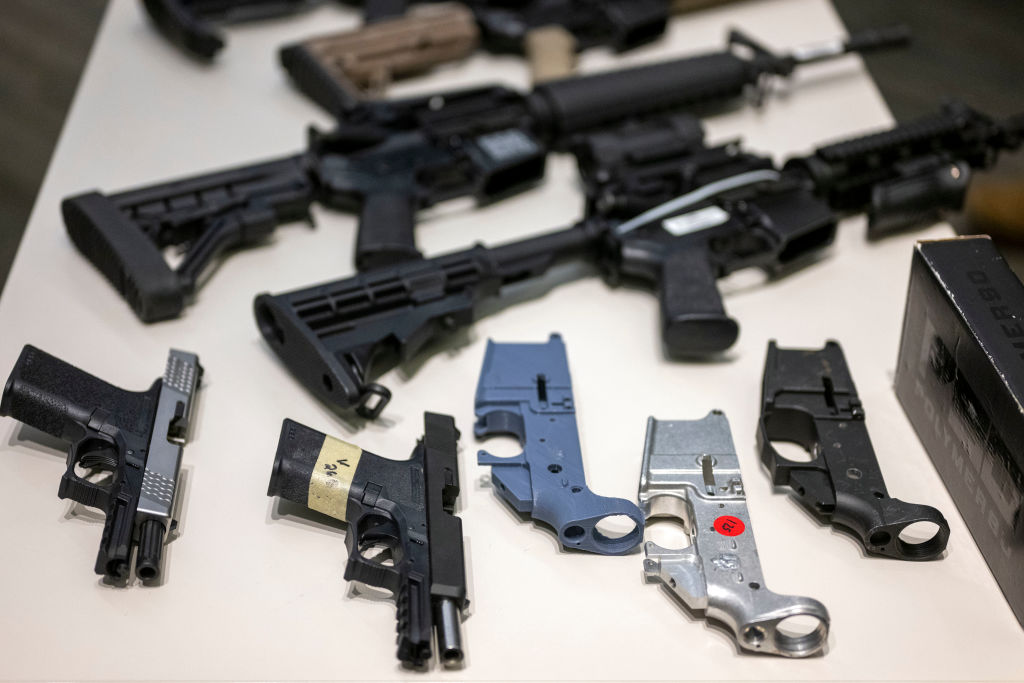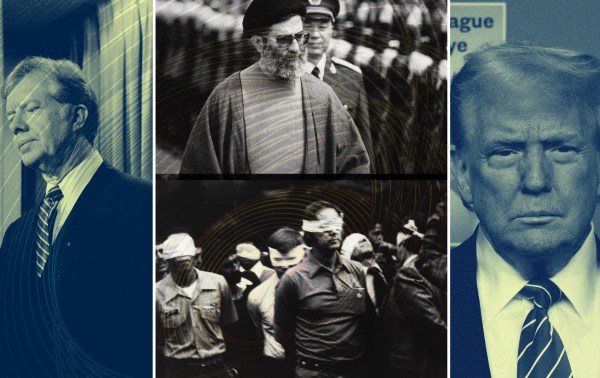Memo to: Mark Joseph Stern
From: The copy desk
Re: Errors, willful misrepresentation, general journalistic incompetence and malpractice, etc.
Mr. Stern:
For my sins, your piece on “ghost guns” and a ruling by the Supreme Court to reinstate a pertinent regulation while it is being challenged came across my desk for editing. Because Slate—and here I mean only the entirely imaginary version of Slate that exists only in my mind for the purpose of this exercise and not the real Slate—has very high editorial standards, particularly when it comes to controversial public matters, I am afraid I cannot let this one see the light of day.
I’ll begin at the beginning:
- “On Tuesday, the Supreme Court sided against criminals who wish to purchase untraceable guns online for the purpose of committing crimes.” This is grandstanding bullsh-t, and you know it. The Supreme Court ruled on the narrow question of whether the regulations in question can remain in force while the matter is litigated. Your formulation is written to imply that the justices who voted otherwise (and who may not endorse the regulations on the legal merits in the future) have simply chosen to “side” with “criminals who wish to purchase untraceable guns online for the purpose of committing crimes.” As you note below that, the justices on either side of the vote are not obliged in this matter to spell out their legal reasoning, and surely this kind of schoolyard-level analysis is not what is called for here, this being—I think!—journalism rather than a campaign speech. Maybe you should think about writing campaign speeches, or at least admitting to the fact that you already are writing campaign speeches.
- “These guns can be purchased on the internet anonymously, without a background check, and assembled in less than an hour.” You are begging the question. According to the ATF regulations that were in place until the change that is now being litigated, these are not guns. That’s the whole legal issue: There isn’t any question that you can sell somebody a gun part, or a dozen gun parts—a new trigger, a replacement barrel, a better-fitting shoulder stock—without that transaction constituting the sale of a firearm under federal law. The question is: How much of a gun can you sell before it counts as a gun sale? That’s a real question, and the ATF’s regulatory latitude in interpreting the statute is not unbounded as a matter of law. This ought to be recognized somewhere in your reporting.
As for the advertised “assembly” time: The copy desk will happily bet you $10,000 that you cannot turn an “80-percent receiver” (as the relevant part is known) into a functioning firearm in less than an hour, because the copy desk assumes you are not an experienced machinist and probably couldn’t say which end jig is compatible with the necessary router that I’m betting you don’t own. I mention this because, contrary to what you have written, it isn’t merely a matter of parts that have to be “assembled.” There is machining work involved—rudimentary work, to be sure, but it isn’t putting together an Ikea bookshelf, either. Selling a box of parts that can simply be “assembled” into a working firearm already is a violation of federal law. This is something that a legal reporter ought to take into account.
- “They are heavily favored by violent offenders because they are virtually impossible to trace, and their use in the United States has spiked by more than 1,000 percent since 2017.” Nope. This is—focus up, now, because this part matters!—not true. I am particularly irked by your use of the old sophomoric “here’s a link that you can be confident supports my assertion when in fact the material linked does not actually support my assertion” gambit, which is relied upon by writers who believe (often with good reason) that their readers are intellectually lazy and interested only in having their biases affirmed. In truth, we don’t really know how prevalent the use of ghost guns in violent crimes actually is—as the National Police Institute paper to which you link makes plain. Here’s the relevant part:

We don’t know much about ghost guns’ use in crimes. The 1,000-percent increase you refer to is in reported ghost-gun recoveries by law enforcement. That isn’t evidence of a ghost-gun crime wave—that is a change in bookkeeping practices. Add to that the fact that even the recovery data is inconsistent (in that some of these are the kit-made guns you are writing about while some are just ordinary guns with the serial numbers removed) and the data are that much farther away from supporting your claim. - “Ghost guns pose an overwhelming threat to public safety because they carve a massive loophole into America’s (already feeble) federal gun laws.” As with the above, there isn’t any reason to believe this is, in fact, true. Over at Everytown, a gun-control group, they keep a tally of ghost-gun related shootings, and their inventory adds up to 138 incidents over a decade, many of them accidental shootings and suicides. That is almost certainly an incomplete record—see the note above about recordkeeping—but it doesn’t document an “overwhelming threat to public safety,” either, at least not in any obvious or demonstrable sense.
- “Typically, to purchase a firearm, you must be a legal adult, undergo a background check, have a clean criminal record, and not be under a restraining order for domestic violence. The gun must have a serial number, and it must be sold by a licensed dealer.” Short version: yes … but, no, no, no, no, and no. It is against the law to buy a firearm if you are a minor or to sell one to a minor. You most certainly may buy a firearm without a “clean criminal record.” Millions of Americans with criminal records—misdemeanor drug offenses, DUIs, petty theft convictions, etc.—are legally eligible to purchase firearms. It generally is against the law for a convicted felon or a defendant under felony indictment to purchase a firearm or to possess one, and it is against the law to knowingly sell a prohibited person a firearm or to otherwise provide him with one. There isn’t any law against private sales of firearms by unlicensed parties, as you damned well know. In such sales, which are pretty common, there isn’t any requirement for a background check or any of the rest of it. What that means is that prohibited buyers already have lots of options, most of them far more convenient, to illegally put their mitts on a firearm than breaking out the drill press and building a firearm at home.
That being so, it should be noted that there isn’t any law against privately manufacturing firearms, and there isn’t any law that says such firearms must have a serial number, a rule that applies only to commercial manufacturers. That doesn’t apply only to 80-percent receivers and kits—it applies to the private manufacture of fully functioning firearms, which is, under federal law, legal. (Of course, if you legally manufacture a firearm you are legally prohibited from possessing, you have broken the law, which is why homemade firearms have to be in compliance with both federal and state laws.) As it stands, there are millions of unserialized firearms in circulation in the United States, mostly guns that were manufactured before serial numbers were mandated, and these change hands every day, often in private sales without a background check, perfectly legally.
And, to be precise, there are millions of law-abiding legal adults who cannot purchase a handgun or some long guns, because these legal adults are not yet 21 years old.
- “When you purchase a ghost gun, however, you exempt yourself from all these rules.” This is not true, except in the sense that when you choose to walk on the sidewalk, you exempt yourself from the rules against driving a truck on the sidewalk. The rules regulating firearms exclude things that are not, under the law, firearms. No amount of question-begging is going to get you around the fact that this is the very matter that is here ultimately in dispute.
- “The gun comes in a ‘kit’ that’s almost fully assembled. With the help of a YouTube tutorial, the buyer can easily put the pieces together in about 20 minutes.” See above: jigs, routers, etc.
- “Because the weapon has no serial number, though, law enforcement almost certainly can’t trace it back to you—which is the point.” There are lots of ways to get your hands on a firearm without a serial number on it—for instance, by removing the serial number on the firearm. The thing is, criminals don’t actually do that all that often. There isn’t usually any point in it. That is because, outside of police procedurals on television, tracing a gun back to a shooter via the serial number isn’t the way crimes typically get solved. (Not to say it never happens.) For one thing, most guns with serial numbers on them cannot be traced back to the criminal, because criminals almost never buy firearms from licensed gun shops and for that reason are not linked in any record to the serial number on the gun. (Of the currently incarcerated criminals who were in possession of a firearm at the time of their crimes, less than 2 percent acquired that firearm through a retail purchase.) A stolen firearm is not traceable to the criminal via serial number; neither is one that has been sold privately or otherwise changed hands six times between its original retail purchase and its use in a crime, which is not uncommon. (Tracing serial numbers can be a pretty good way to identify straw buyers–unfortunately, very little effort is put into investigating or prosecuting those cases.) So, while it certainly is true that “ghost guns” are untraceable via the serial-number process, as a practical matter, the great majority of commercially manufactured and serialized firearms cannot be traced back to a criminal via serial number, either. The most common way for police to connect a criminal to a firearm is finding the firearm on the criminal, or in his home or vehicle, at the time of arrest.
- “Of the 45,240 ghost guns recovered from 2016 to 2021, only 445 could be traced, a success rate well under 1 percent.” That’s interesting—if they have no serial number, how were they traced? That’s the kind of thing a journalist might be interested in finding out and reporting to his readers.
- “These guns are driving a surge in violent crime and neutering the few federal laws on the books that restrict dangerous individuals’ access to firearms.” As with your earlier non-authoritative link, this one contains almost no actual data supporting your assertion, though it does contain some subjective impressions from gun-control advocates. If you check the actual ATF data—and why wouldn’t you check the actual ATF data?—things look a little different. From 2017 to 2021, there were just short of 2 million firearms submitted by state and local law enforcement to the ATF for tracing. ATF failed to identify the original purchaser in about 20 percent or 25 percent of these cases, depending on the year, mostly because of incomplete records or because the firearms were so old that serial numbers hadn’t been required at the time of their manufacture. But here’s an interesting thing: Out of those 2 million or so firearms, only 1.9 percent were so-called ghost guns, or “privately made firearms” in ATF-speak. For comparison, an almost equal share, about 1.3 percent of those firearms, couldn’t be traced back to a retailer because they originated in government agencies—i.e., they were firearms issued to police or soldiers before being used in crimes, and therefore did not enter circulation through the retail process. How is it that the 1.9 percent that are ghost guns are driving a panic-inducing crime wave while the 1.3 percent that are police guns somehow are beneath notice? Inquiring minds, etc.
- “The law also covers ‘the frame or receiver of any such weapon,’ two integral components of a firearm.” No. “Frame or receiver” is two ways of referring to the same thing, not “two integral components.” The ATF rule uses “frame” for a handgun and “receiver” for most other kinds of firearms. It bears repeating: A finished receiver is, as far as federal law is concerned, a firearm, and already is regulated as such.
- “The rule prompted a flurry of litigation as conservative lawyers fanned out through the courts filing lawsuits before Republican-appointed judges most likely to rule in their favor.” Wait—you’re telling me that lawyers go out of their way to get their cases into courts they perceive to be likely to rule in favor of their clients? Well, raise my rent!
- “[Judge] O’Connor ruled that ghost gun kits contain mere ‘weapon parts,’ which ATF has “no general authority to regulate.’” While the word “mere” does not appear in the ATF rules, “weapon parts” is precisely how the ATF describes what the agency purports to be regulating–the phrasing is not Judge O’Connor’s invention. This probably is not the best use of sneer quotes by a “journalist.”
On a broader note, you write from the assumption that Supreme Court justices simply make policy choices (“siding with” this party or the other one) rather than rule on legal matters according to legal criteria—which says a lot more about your view of the role of judges than it does, say, Justice Clarence Thomas’ view. You know the old cliché that liars think everybody is lying, cheaters think everybody is cheating, etc. In a similar way, people who believe that judicial activism—judges simply imposing their policy preferences on the country irrespective of the law—is the right and proper mode of action for the Supreme Court also assume that everybody else thinks that way, and complain only when the courts impose some other set of policy preferences. I note that many of your progressive-leaning colleagues are, from time to time, mystified when so-called conservatives on the Supreme Court come to the same conclusion as the progressive activists; you yourself marvel at the “unprecedented coalition” joining Roberts and Barrett with the court’s three progressives, and you engage in some very fun Kremlinology about such coalitions while more or less ignoring the possibility that Roberts and Barrett—and Thomas and Kavanaugh and Alito and Gorsuch—are actually doing what they say they want to do, which is to follow the law on the law’s own terms, even if it produces outcomes that are other than those they would prefer as a policy matter. I am, generally speaking, pro-cynicism, but you shouldn’t let your cynicism blind you to more plausible and straightforward accounts of the case.
If it stands, the new ATF rule is very likely to make things even dumber and more arbitrary than the status quo; for example, a hunk of metal that can be machined into a rifle receiver may not be a firearm as far as the ATF is concerned, but the same hunk of metal sold with instructions for machining it into a finished receiver may be, and the ATF will consider all sorts of subjective factors—including its interpretation of marketing materials!—in determining whether a particular piece of metal or plastic that can be made into part of a firearm already is a firearm in its regulatory view. That’s going to be interesting: If an unfinished receiver is a firearm because of the way it is marketed, then changing the marketing approach should, logically, change the regulatory status of the object in question. That right there is some semi-Orwellian meta weirdness. It’s also the kind of thing that ought to interest a journalist.
Obviously, we can’t publish this mess. Slate has journalistic standards, after all.







Please note that we at The Dispatch hold ourselves, our work, and our commenters to a higher standard than other places on the internet. We welcome comments that foster genuine debate or discussion—including comments critical of us or our work—but responses that include ad hominem attacks on fellow Dispatch members or are intended to stoke fear and anger may be moderated.
With your membership, you only have the ability to comment on The Morning Dispatch articles. Consider upgrading to join the conversation everywhere.